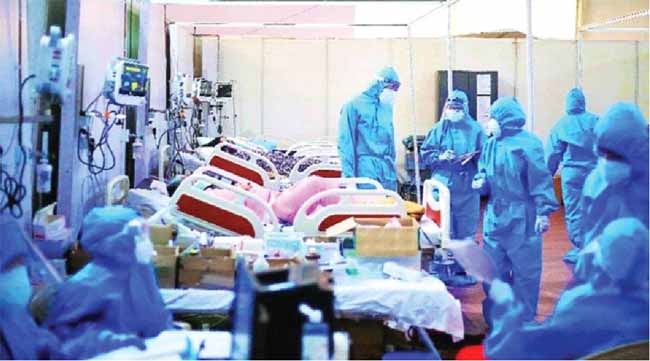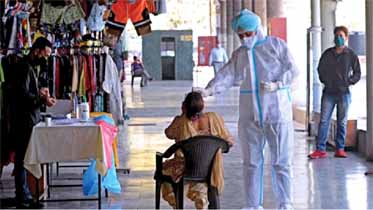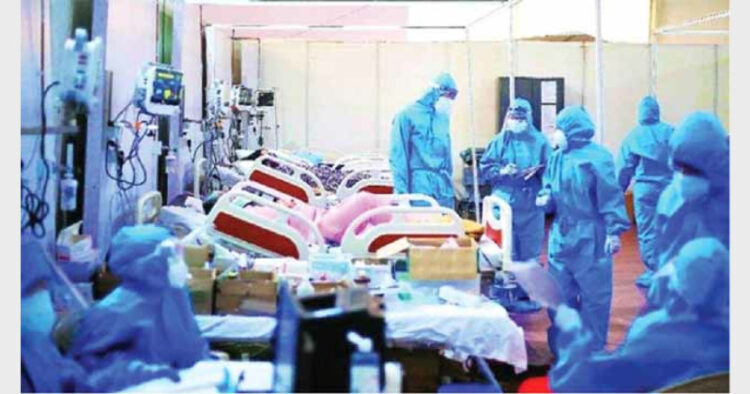The Central Government’s preparatory measures for potential Covid third wave is a laudable step. From June 21 onwards, the Government of India will provide free jabs to all Indian citizens above 18 years. It will be a befitting reply to the Opposition which has been quite vocal against the Government
-Stuti Sardana

The Central Government is taking steps in the right direction to counter the global pandemic
“The past is where you learned the
lesson. The future is where you apply the Lesson”.
Continued vigilance in terms of pandemic preparedness, upscaling health spending and health infrastructure, faster rollout of vaccination, investing in research and development to guard against possible mutants of the virus, prudent restrictions, and strict observance of COVID-appropriate behaviour are essential to maintain the delicate balance of lives and livelihoods, and to face the challenges of expected third wave.
There have been many measures taken by the Modi Government, in order to cope up with the deadly second wave of COVID on the one hand, and gradually preparing itself to battle with the third wave. These measures are highly focused on children, in particular, as they are expected to be the ‘targets’ in the third wave. Plus, the areas where Government’s preparations fell short in the second wave, such as availability of oxygen, life saving drugs, hospital beds along with medical staff and role of administration are the major focus this time. Another important aspect that can lead to a third wave is the rural population of the nation, So a clear strategy is required to combat this. And the most important aspect has been the vaccination of a large population of the nation, in order to achieve a level of herd immunity.
Ramping up Vaccines
He was also apprised about the efforts undertaken to help various vaccine manufacturers to ramp up production of vaccines. The Government of India is actively working with vaccine As many states came forward with a demand for reconsideration of the vaccination strategy and for bringing back the system that was there before 1st May, Prime Minister Narendra Modi announced that it has been decided that the 25 per cent vaccination that was with states will now be undertaken by the Government of India. From 21st June onwards, Government of India will provide free vaccines to all Indian citizens above 18 years of age. Government will buy 75 per cent of the total production of the vaccine producers and provide to the states free of cost. No state government would be spending anything for vaccines. Till now, crores of people got free vaccines, now the 18 years segment will be added to this. PM is continuously monitoring the current availability of vaccines and the roadmap for ramping it up.manufacturers and helping them in terms of facilitating more production units, financing and supply of raw materials.
As many states came forward with a demand for reconsideration of the vaccination strategy and for bringing back the system that was there before 1st May, Prime Minister Narendra Modi announced that it has been decided that the 25 per cent vaccination that was with states will now be undertaken by the Government of India. … PM is continuously monitoring the current availability of vaccines and the roadmap for ramping it up
The Centre has come out with a set of fresh guidelines for the care and protection of children affected by COVID-19. The government has fixed responsibilities for the states, district magistrates, police, Panchayati Raj institutions, and urban local bodies. The Women and Child Development Ministry has written to the chief secretaries of all the states and Union territories directing them to streamline and facilitate the actions being taken. Even the Drugs Controller General of India gave permission for conducting Phase II/III trials of Bharat Biotech’s Covaxin in the 2-18 age group. This gives hope to have the nation’s own covid vaccination for children soon. The Ministry of Health, too, has issued clinical guidelines for management of Covid in children. The states and Union territories have been asked to temporarily allocate child care institutions (CCIs) to house those children whose parents have been unwell due to COVID-19 and provide the necessary support to them, in case the extended family is not available.
Delivering Oxygen
Overcoming all hurdles and finding new solutions, Indian Railways is continuing its journey of bringing relief by delivering Liquid Medical Oxygen (LMO) to various states across the country. Oxygen Expresses crossed the mark of 28000 MT of LMO delivery in service to the nation. So far, Indian Railways has delivered nearly 28473 MT of LMO in more than 1648 tankers to various states across the country. Till now Oxygen Expresses offloaded LMO in around 39 cities/towns in 15 states across the country Indian Railways has mapped different routes with oxygen supply locations and keeps itself ready with any emerging need of the States. In order to ensure that oxygen relief reaches in the fastest time possible, Railways is creating new standards and unprecedented benchmarks in running of Oxygen Express Freight Trains. The average speed of these critical Freight trains is way above 55 in most cases over long distances. Running on high priority Green Corridor, with a highest sense of urgency, operational teams of various zones are working round the clock in the most challenging circumstances to ensure that Oxygen reaches in the fastest possible time frame. The IAF has been engaged in airlifting of oxygen both within and outside the country since April 21 and has created special teams and crews for these operations. The IAF has flown to more than nine countries including Germany, Indonesia, Australia, Britain and Singapore to bring oxygen containers and plants. It has flown over 32 sorties of its transport aircraft and helicopters to move 498 oxygen tankers from both within India and abroad to help the country amid the oxygen shortage.
The Narendra Modi government has told top pharmaceutical companies to begin preparations for the third COVID-19 wave and keep stock of key drugs ready in the next two to three months. The Department of Pharmaceuticals (DoP) — the apex regulator for drug makers in India under the Ministry of Chemicals and Fertilisers — asked pharma companies and lobbies to prepare stock of key Covid drugs, anticipating the third wave of the novel coronavirus. The list includes all the medicines that have played a key role in the treatment of Covid patients, but the production of Remdesivir in particular has gone up from 38 lakh vials per month to 119 lakh vials per month.
Augmenting Beds and Tests
The entire medical fraternity and the paramedical staff have shown exemplary fight against the extraordinary circumstances of the second wave of Covid, Be it testing, supply of medicines or set-up of new infrastructure in record time, all these are being done at a fast pace. Several challenges of oxygen production and supply are being overcome. The steps taken by the country to augment human resources, like including MBBS students in Covid treatment, and ASHAs and Anganwadi workers in rural areas, provided extra support to the health system. Government has urged doctors to include an oxygen audit in their daily efforts.
As a large number of patients are undergoing treatment in ‘home isolation’, the doctors are being instructed to ensure that the home-based care of every patient is SOP driven. Telemedicine has played a big role for patients in home isolation, and this service needs to be expanded in rural areas as well. The Government appealed to doctors across the states to form similar teams, train final year MBBS students and MBBS interns, and work towards ensuring that all tehsils and districts of the country have telemedicine service. Medical Infrastructure has been a major focus, which includes the setting up various new hospital beds and supply of ventilators at a large number. Augmenting the process of Testing, with multi-methods is another aspect given too much importance during and post second wave, that has helped to curb the situation largely.

Tackling the Chinese virus requires commitment
As a large number of patients are undergoing treatment in ‘home isolation’, the doctors are being instructed to ensure that the home-based care of every patient is SOP driven… The Government appealed to doctors across the states to form similar teams, train final year MBBS students and MBBS interns, and work towards ensuring that all tehsils and districts of the country have telemedicine service
PM Modi has been continuously interacting with the state and district officials on the COVID-19 situation and discussing about the improving covid situation in their respective districts, their experience of using technology for real-time monitoring and capacity building, and about the steps taken to enhance public participation and awareness in their districts. PM urged everyone to ensure full commitment to fight the pandemic. He added, Coronavirus has made the work more demanding and challenging. In the midst of these new challenges, new strategies and solutions are needed. He also warned that the challenge remains as long as this infection is present even on the minor scale. He said experiences and feedback from their work in the field, helped in making practical and effective policies. He focuses on small COVID containment zones as the effective strategy to fight the virus. He emphasised that the methods and strategies in dealing with the pandemic should be dynamic as the virus is expert in mutation and changing the format and stressed on the need to use local experiences and the need to work together
Combating Covid in Rural Bharat
To combat Covid-19, the government has asked states to sensitise and facilitate the Panchayats/Rural Local Bodies to tackle the Covid challenge. The Union Ministry of Panchayati Raj has written to all the state governments to take preventive measures to curb the spread of the Covid-19 pandemic in rural India. The Ministry has advised undertaking an intensive communication campaign for the awareness of rural communities on the nature of the Covid infection and preventive and mitigation measures, by the advice of the Health Ministry, doctors, and medical institutions, etc., while especially taking care to dispel false notions and beliefs. The Ministry has asked state governments to involve frontline volunteers from the local community for the campaign, such as elected panchayat representatives, teachers, and ASHA workers. They may also be suitably facilitated with necessary protective systems like finger oxy-meters, N-95 masks, infrared thermal scanning instruments, sanitisers, etc. Rapid Testing & Vaccinations should be the major strategy in villages, to confront covid.
The Government has a clear strategy and road map to confront the potential third wave. All the shortcomings from the second wave have been the major focus areas, and required actions have been continuously taking place. Despite the few challenges of the second wave, PM Modi retains his trust of being a responsible and efficient leader among people, which is the strongest reason that India has been battling the pandemic so well.














Comments